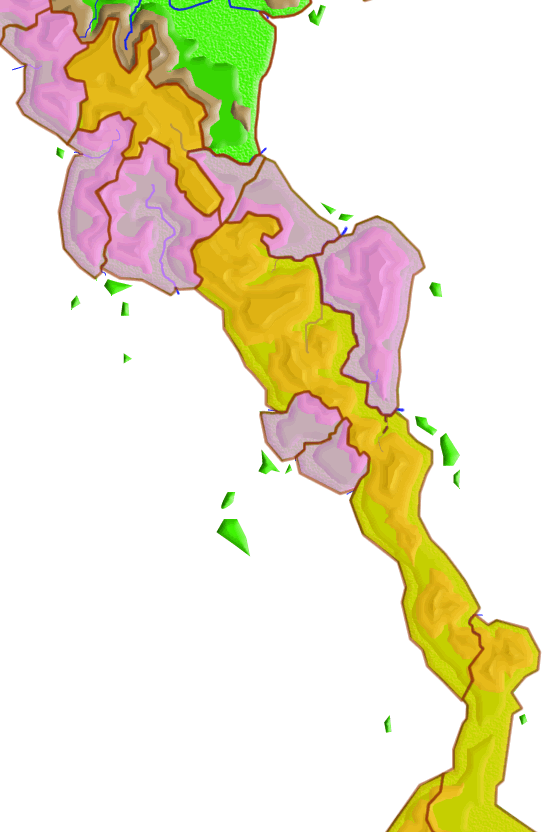The Bridge of Fire
The Fiery Isthmus is a volcanically active land bridge that connects the main body of Teréðor with Sul-Tèreðor, its southern-most tip. The isthmus is bounded to the east by the Sea of Dekàlas and to the west by the Mar Kìrydi. The Unuma rivers form a natural and “political” border for the northern end of the isthmus. The southern shores of this chain of rivers and lakes is dotted with ruined Yrūn forts and temples thought to have been built in the later parts of the Third Age. If true, these would be among the oldest standing Yrūn structures in Teréðor, predating the Old Empire by over 1600 years. The southern extent of the isthmus borders the wild lands of Sul-Tèreðor beyond the river Mataa (meaning “death” in the local tribal tongue).Early Kirydian explorers sailing along the isthmus coast reported that the land was shrouded in smoke and that the hills and mountains raged with great walls of fire. The Fiery Isthmus was formed by an active chain of volcanoes that continue across the mouth of the Inner Sea of Sul-Tèreðor, terminating with the great shards of Karaskaa. The region is so active in fact, that volcanoes along the chain can usually be seen smoking, spitting ash, and releasing pyroclastic flows throughout the interior. For these reasons, most of the inhabitants of the Fiery Isthmus live on the coasts, or at least the slopes of dormant volcanoes.
The rain forests of the Fiery Isthmus are among the most lush forests known in the World of Teréth End, second only perhaps to the Dreamland jungles of Jædð. The forests are home to a great variety of animals and plants never categorized or even seen by Yrūni explorers (who tend to stray away from the more dangerous interior). Alchemist and Arcanist guilds trade heavily with the indigenous peoples for exotic flowers, powders, and animal products.
Inhabitants of the Fiery Isthmus have a reputation of being tribal savages which consort with demons and practice cannibalism. In fact, there are many hundreds of tribes along the isthmus, and its unfair to judge the entirety of the populace on accounts garnered from a handful of tribes. For the most part, the tribes of the Fiery Isthmus do not established strict political boundaries, preferring instead to use land and resources as needed. This is possible in the countryside where the majority of tribes subsist in hunter-gatherer communities. In population centers land around a given town or city is generally parceled by a central authority to support and protect crops and structural property. Another impetus for the creation of ownership rights has been the introduction of foreign businesses that wish to protect their interests and physical investments.
Regions, Geographic
- The Smoking Coast
Regions, Political
Cities, Towns, and Villages
Landmarks
People
- Boor. The Boor (not to be confused with the Bor) are a confederacy of primitive tribes that live along the Mar Kìrydi in the northern reaches of the Fiery Isthmus. Perhaps the most famous Boor, a member of the Gom tribe, is Tombor (rf. Black Tom).
- Dari. A civilized Yrūni tribe of women that have proven to be prolific breeders despite a conspicuous absence of men. The culture has a strong religious core, with the center of each community being a temple or chapel devoted to a male saint or progenitor.
